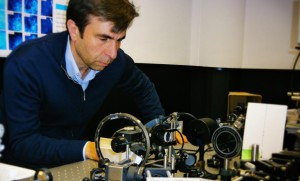In a recent review article,1 the potential visual benefit of aspheric intraocular lenses (IOLs) was addressed. Unfortunately, the historical context of the development of this important technology was not properly covered. In my opinion, the article failed to cite the relevant literature on the basics of aspheric IOLs and their theoretical limitations. This may prevent the readers from a complete and accurate view of the problem. As one of the individuals directly involved in the development of the first aspheric IOL,2 together with Sverker Norrby and Patricia Piers, I would like to briefly summarize how this development actually happened. The initial concept of an IOL to correct the spherical aberration of the cornea came from a better understanding of the nature of the optical aberrations in the young eye and how these aberrations are modified by aging.
The relative contribution of the cornea and the lens to the retinal image has attracted the attention of scientists since Thomas Young in the XIX century. More recently, in 1973, El Hage and Berny3 measured corneal spherical aberrations using a photokeratoscope and ocular spherical aberrations using a Foucault knife-edge test. They observed that the corneal values were more positive than the total eye values, which were the result of the negative values for the lens spherical aberration. A coupling of other higher-order aberrations between the cornea and lens was discovered later.4,5 In addition to the spherical aberration, horizontal corneal coma is mostly compensated by the crystalline lens.6,7 This mechanism in the young eye resembles an aplanatic optical design,8 in which both spherical aberration and coma are corrected.
Normal aging degrades the eye’s optical image quality.9 Whether this change is a consequence of a deteriorated aging cornea or due to changes in the human lens was an interesting open question, finally elucidated in the context of the balance of aberrations previously described. The corneal aberrations seem to be stable with age,10,11 but the lens12 showed spherical aberration changes, from negative values in the young lens to more positive values in the older lens. This favored the hypothesis of a loss of the balance between aberrations of the cornea and the lens as a consequence of the changes in the aging human crystalline lens. This was first demonstrated experimentally in a study13 in which corneal and ocular aberrations as a function of age were measured simultaneously. The balance of spherical aberration and coma between the cornea and lens present in younger subjects was disrupted by normal aging.
With this understanding of aberration coupling in the older eye, we further evaluated the situation in eyes after IOL implantation. The first experimental studies of the in vivo optical quality of eyes implanted with IOLs showed some unexpected results.14 The objective retinal image quality appeared to be similar to that in normal patients of the same age. Intraocular lenses were manufactured with high optical quality standards,15 having better quality than the isolated older human lens. However, when these IOLs were implanted in the eye, the resulting overall quality was not significantly improved. The compensation of aberrations in the eye provided an explanation to this apparent paradox and, more interesting, a potential solution.16 The best IOL would not be a perfect (aberration-free) lens but rather the IOL with aberrations opposite those of the corneal aberrations, mimicking the situation in the young crystalline lens. These ideas opened a new era in the optical design of IOLs.
It should be mentioned that aspheric IOLs had been suggested earlier,17 but not in the context of a proper understanding of the compensation of aberration. The aspheric-optic technology was the platform optimized to design an IOL with negative spherical aberration, with a mean value similar to that of the cornea but with the opposite sign (Tecnis IOL, Abbott Medical Optics). The path to the discovery of this technology is a good example of how better understanding of the basic optical mechanisms of the eye was used to improve patients’ quality of vision.
Another important aspect not properly covered in the review article was the evaluation of the limitations of spherical aberration–correcting IOLs using customized ray-tracing modeling.18,19 These studies were initially used to set the ranges of the theoretical optical improvements. The potential visual benefit of these types of IOLs, and their limitations, has been extensively reported in the clinical literature.


